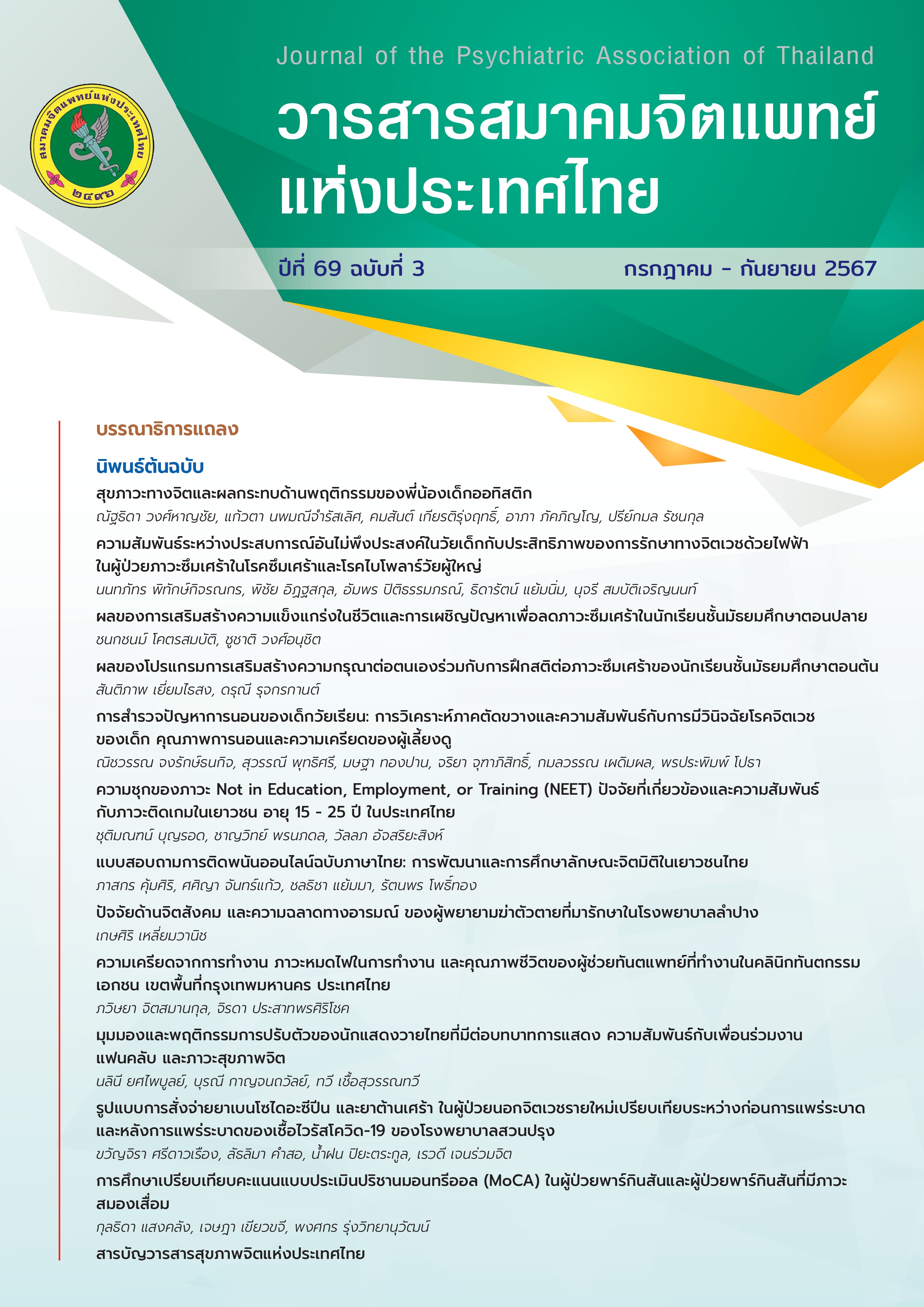Comparison of Benzodiazepines and Antidepressants Prescribing Pattern among New Psychiatric Outpatients before and after the COVID-19 Pandemic in Suanprung Psychiatric Hospital
Main Article Content
Abstract
Objective: To compare medication prescribing patterns of benzodiazepines and antidepressants among new psychiatric outpatients at Suanprung Psychiatric Hospital before and after the COVID-19 pandemic, and to investigate factors that influenced medication prescribing patterns.
Methods: A retrospective cohort study was conducted using the electronic database and medical record form between March 2018 and February 2022. The population was new psychiatric outpatients receiving services at Suanprung Psychiatric Hospital. The logistic regression, independent T-test, and Fisher's exact test were used for statistical analysis.
Results: The participants consisted of 15,596 people with 8,663 classified as "Pre-COVID-19" group and 6,933 as "Post-COVID-19" group. Prevalence of benzodiazepines and/or antidepressants prescribed were at a higher rate in the "Post-COVID-19 Pandemic" group than in the "Pre-COVID-19" group (OR, 1.15 [95% CI, 1.03-1.29]; P=0.010). When adjusting the covariates factors, it was found, the prevalence of benzodiazepines prescribing increased significantly (OR, 1.21 [95% CI, 1.12-1.30]; P<0.001), while the prevalence of benzodiazepines prescribing increased significantly of antidepressants prescribing increased non-significantly (OR, 1.04 [95% CI, 0.95-1.13]; P=0.397).
Conclusion: Prescriptions for benzodiazepines and/or antidepressants was increasing in prevalence in the "Post- COVID-19" compared to "Pre-COVID-19", particularly for benzodiazepines. This may be a result of the proportion of patients diagnosed with anxiety disorders increasing after the COVID-19 pandemic. In contrast, the dose per day decreased in the "Post-COVID-19". In the case of a pandemic, drug prescribing patterns will be useful in designing the drug management system in psychiatric hospitals to meet emergency services and pharmaceutical care needs.
Article Details

This work is licensed under a Creative Commons Attribution-NonCommercial-NoDerivatives 4.0 International License.
Articles submitted for consideration must not have been previously published or accepted for publication in any other journal, and must not be under review by any other journal.
References
da Rosa Mesquita R, Francelino Silva Junior LC, Santos Santana FM, Farias de Oliveira T, Campos Alcântara R, Monteiro Arnozo G, et al. Clinical manifestations of COVID-19 in the general population: systematic review. Wien Klin Wochenschr 2021;133(7-8):377-82.
Bertini CD Jr, Khawaja F, Sheshadri A. Coronavirus disease-2019 in the immunocompromised host. Clin Chest Med 2023;44(2):395-406.
Koçak O, Koçak Ö E, Younis MZ. The psychological consequences of COVID-19 fear and the moderator effects of individuals' underlying illness and witnessing Infected friends and family. Int J Environ Res Public Health 2021;18(4).
Corpuz JCG. Adapting to the culture of ‘new normal’: an emerging response to COVID-19. J Public Health 2021;43(2):e344-e5.
Antipova A. Analysis of the COVID-19 impacts on employment and unemployment across the multi-dimensional social disadvantaged areas. Soc Sci Humanit Open 2021;4(1):100224.
Xiong J, Lipsitz O, Nasri F, Lui LMW, Gill H, Phan L, et al. Impact of COVID-19 pandemic on mental health in the general population: a systematic review. J Affect Disord 2020;277:55-64.
Salari N, Hosseinian-Far A, Jalali R, Vaisi-Raygani A, Rasoulpoor S, Mohammadi M, et al. Prevalence of stress, anxiety, depression among the general population during the COVID-19 pandemic: a systematic review and meta-analysis. Global Health 2020;16(1):57.
Campitelli MA, Bronskill SE, Maclagan LC, Harris DA, Cotton CA, Tadrous M, et al. Comparison of medication prescribing before and after the COVID-19 pandemic among nursing home residents in Ontario, Canada. JAMA Netw Open 2021;4(8):e2118441.
Metin A, Erbiçer ES, Şen S, Çetinkaya A. Gender and COVID-19 related fear and anxiety: a meta-analysis. J Affect Disord 2022;310:384-95.
Uthayakumar S, Tadrous M, Vigod SN, Kitchen SA, Gomes T. The effects of COVID-19 on the dispensing rates of antidepressants and benzodiazepines in Canada. Depress Anxiety 2022;39(2):156-62.
Bandelow B, Zohar J, Hollander E, Kasper S, Möller HJ, Zohar J, et al. World federation of societies of biological psychiatry (WFSBP) guidelines for the pharmacological treatment of anxiety, obsessive-compulsive and post-traumatic stress disorders - first revision. World J Biol Psychiatry 2008;9(4):248-312.
Department of Mental Health, Ministry of Public Health, Thailand. Clinical practice guideline of major depressive disorder for general practitioner: CPG-MDD-GP. Bangkok: Department of Mental Health; 2010.
Preskorn SH, Borges-Gonzalez S, Flockhart D. Clinically relevant pharmacology of neuropsychiatric drugs approved over the last three years: part II. J Psychiatr Pract 2006;12(5):312-6.
Mu A, Weinberg E, Moulin DE, Clarke H. Pharmacologic management of chronic neuropathic pain: review of the Canadian pain society consensus statement. Can Fam Physician 2017;63(11):844-52.
Susman J, Klee B. The role of high-potency benzodiazepines in the treatment of panic disorder. Prim Care Companion J Clin Psychiatry 2005;7(1):5-11.


